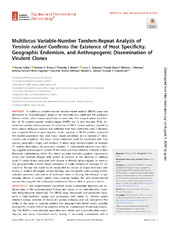Multilocus variable-number tandem-repeat analysis of Yersinia ruckeri confirms the existence of host specificity, geographic endemism, and anthropogenic dissemination of virulent clones
Gulla, Snorre; Barnes, Andrew C.; Welch, Timothy J.; Romalde, Jesús L.; Ryder, David; Ormsby, Michael J.; Carson, Jeremy; Lagesen, Karin; Verner-Jeffreys, David W.; Davies, Robert L.; Colquhoun, Duncan John
Peer reviewed, Journal article
Published version

Åpne
Permanent lenke
http://hdl.handle.net/1956/20964Utgivelsesdato
2018-08Metadata
Vis full innførselSamlinger
Originalversjon
https://doi.org/10.1128/aem.00730-18Sammendrag
A multilocus variable-number tandem-repeat analysis (MLVA) assay was developed for epizootiological study of the internationally significant fish pathogen Yersinia ruckeri, which causes yersiniosis in salmonids. The assay involves amplification of 10 variable-number tandem-repeat (VNTR) loci in two five-plex PCRs, followed by capillary electrophoresis. A collection of 484 Y. ruckeri isolates, originating from various biological sources and collected from four continents over 7 decades, was analyzed. Minimum-spanning-tree cluster analysis of MLVA profiles separated the studied population into nine major clonal complexes and a number of minor clusters and singletons. The major clonal complexes could be associated with host species, geographic origin, and serotype. A single large clonal complex of serotype O1 isolates dominating the yersiniosis situation in international rainbow trout farming suggests anthropogenic spread of this clone, possibly related to transport of fish. Moreover, subclustering within this clonal complex indicates putative transmission routes and multiple biotype shift events. In contrast to the situation in rainbow trout, Y. ruckeri strains associated with disease in Atlantic salmon appear as more or less geographically isolated clonal complexes. A single complex of serotype O1 exclusive to Norway was found to be responsible for almost all major yersiniosis outbreaks in modern Norwegian salmon farming, and site-specific subclustering further indicates persistent colonization of freshwater farms in Norway. Identification of genetically diverse Y. ruckeri isolates from clinically healthy fish and environmental sources also suggests the widespread existence of less-virulent or avirulent strains.
